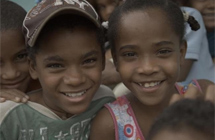神秘村庄:女孩长大自动变男性
|
In every way, Johnny is physically and biologically male. But, astonishingly he did not grow a penis until he hit puberty. He is one of many children who live in Salinas, an isolated village in the southwestern Dominican Republic, who are seemingly born female, only to become men in their teenage years. Although Johnny’s story may seem extraordinary, cases of little girls turning into boys are so prevalent in the village that it is no longer considered abnormal. The children are simply referred to as the ‘guevedoces’ – which literally translates as ‘penis at 12’.
Johnny, 24, was originally named Felecitia by his parents and brought up as a girl. He spoke to Dr Michael Mosley for the new BBC2 series “Countdown to Life – the extraordinary making of you". “I remember I used to wear a little red dress,” he said. “I was born at home instead of in a hospital. They didn’t know what sex I was. “I went to school and I used to wear my skirt. I never liked to dress as a girl. When they bought me girls toys I never bothered playing with them. All I wanted to do was play with the boys.” The rare genetic disorder occurs because of a missing enzyme which prevents the production of a specific form of the male sex hormone - dihydro-testosterone - in the womb. All babies in the womb, whether male or female, have internal glands known as gonads and a small bump between their legs called a tubercle. At around eight weeks, male babies who carry the Y chromosome start to produce dihydro-testosterone in large amounts, which turns the tubercle into a penis. For females, the tubercle becomes a clitoris. But some male babies are missing the enzyme 5-α-reductase which triggers the hormone surge, so they appear to be born female with no testes and what appears to be a vagina. It is not until puberty, when another huge surge of testosterone is produced, that the male reproductive organs emerge. What should have happened in the womb happens around 12 years later. Their voices deepen and they finally grow a penis. For Johnny it happened at the age of seven. He claimed that he had never felt like a little girl and was far happier after he fully became a boy. “When I changed I was happy with my life,” he said. A little girl named Carla is currently going through the same transformation, aged nine. Despite being brought up as a girl, his mother noticed that from the age of five he was more inclined towards the rough and tumble play of little boys. He has recently had his hair cut short after wearing plaits for years. “I feel like a man now,” he said. Many decide not to change from their female names, so some men in Salinas have names like Catherine. Further cases have since been seen in the Sambian villages of Papua New Guinea although the Sambians view the children as flawed males and they are often shunned, unlike the Dominicans who welcome the transformation with widespread celebration. Around one in 90 children in Salinas are guevedoces and although they resemble sexually normal males, subtle differences do still exist in adulthood. Most have decreased amounts of facial hair and smaller prostate glands relative to the average male. It is thought that the condition has persisted through generations because of the isolation of the villagers. Because the disorder is so widespread and accepted, the Dominican Republic now believes that there are three sexual categories, male, female, and pseudohermaphrodite. |









